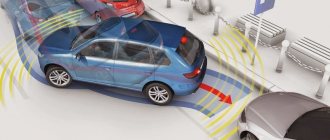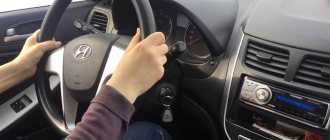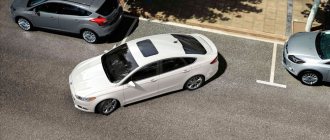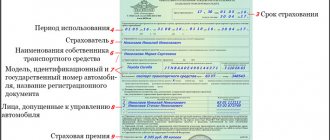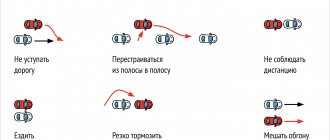Not all driving school cadets can pass the practical driving test flawlessly. Anxiety and lack of training can delay obtaining your coveted driver's license indefinitely. Only those who have thoroughly prepared for it can pass this test, and not only at the training ground. Let's take a closer look at the correct execution of exercises on the race track.
Scheme of the circuit (training site)
At the training ground or race track in a driving school and when passing a practical exam at the State Traffic Safety Inspectorate, you will need to master and pass 6 exercises:
- 1. “Stopping and starting movement on an incline (overpass, hill)”;
- 2. “Turns by 90 degrees”;
- 3. “Turning in a confined space”;
- 4. “Snake”;
- 5. “Entering the garage (boxing) in reverse”;
- 6. “Parallel parking in reverse”;
The most common reasons for failing practical exams in the traffic police
There are only three main reasons for failing exams, and each of them can be dealt with.
You can fail the traffic police exam due to inattention, uncertainty and poor knowledge of traffic rules.
Uncertainty, excitement. Often, a cadet who has performed the entire practical part superbly on a training machine suddenly begins to worry and jitters during the exam. It would seem that what is so difficult here? After all, the exam takes place in a driving school car, in which a person has driven several dozen hours and had time to thoroughly prepare. However, an important role here is played by the very fact of demonstrating one’s skills and the unapproachably stern face of the employee, who demonstrates skepticism with his entire appearance. Well, how can you not get excited and forget to turn on the turn signal, or forget what exercises are taken at the race track? There is only one way out of this situation - try to calm down at all costs. If you can’t do this on your own, then you need to take a couple of valerian tablets (a couple, no more!) and try to convince yourself that this is an ordinary study trip. Inattention It is quite difficult for a beginner to concentrate on the road and carefully monitor traffic lights, signs and passing cars. Moreover, if he believes that the rules were created for fools and no one follows them anyway. Most often, such smart people take exams 8-10 times and sincerely do not understand why they were cut off.
Well, just think, I parked three meters from the turn, along a double solid road? There was no one there and no cars were passing there at that moment! And he did not take into account the fact that this would-be driver blocked all visibility and created the possibility of an emergency.
In this case, we can advise you to once again go over the traffic rules before taking the test and understand the importance of behavior on the road. The slightest deviation from the rules can lead to serious consequences, so the driver must have attentiveness in his blood.
Poor knowledge of traffic rules
Here you don’t even need to explain anything and all that remains is to recommend learning the rules as quickly as possible and trying to pass the exam again with new knowledge.
Exercise: Stopping and starting on a climb (overpass, hill)
Driver candidate:
- stops the vehicle in front of the “STOP-1” line, without crossing the front clearance of the vehicle with its projection, so that all wheels are on the lifting section;
- fixes the vehicle in a stationary state;
- continues to move in a forward direction, preventing the vehicle from rolling back more than 0.3 m;
- stops in front of the “STOP-2” line at a distance of no more than 1 m, engages neutral gear (when performing the exercise on a vehicle with a manual gearbox) and fixes the vehicle in a stationary state;
- leaves the exercise area, crossing the “STOP-2” line.
The magnitude of the rollback is recorded by the examiner by placing a control stand at least 1 m high at a distance of 0.3 m from the projection of the rear marker after the vehicle stops in front of the “STOP-1” line or by an automated system for monitoring and assessing the vehicle driving skills of driver candidates.
How to pass a race track the first time
Most candidates succeed in passing the test on the first try. It's important to keep a few things in mind:
- set yourself up for success, but do without sedative pills (they can interfere with concentration, cause drowsiness, and slow down your reaction);
- wear comfortable clothes and shoes (women are better off without heels, replacing them with comfortable moccasins);
- remember that enough time is allotted for each maneuver so that you do them slowly;
- Use car mirrors during exercises.
Maximum delivery time
The period during which the applicant must pass the test is limited to
depending on the distance and number of maneuvers. Each task is given 2 minutes.
Time is also given to cover the distance between sections separated for different stages. Each of them is usually 250 m. That is, the total time to complete the circuit is 10-12 minutes.
If the applicant completes some task faster, he will be able to stay longer on another maneuver. The main thing is that the total period of stay on the site does not exceed the permissible value.
Travel speed
When performing the exercise on the site, the speed should be low, the optimal value is 10 km or slightly higher. This mode will allow you to complete all tasks on time and not make mistakes. After all, you will have to use only first or reverse gear, where the latter is necessary. And you don't need to waste time switching gears.
More on AutoLex.Net:
The last group of symbols from Appendix 1 of the Traffic Regulations are additional information signs: characteristics, features
Driver equipment
The clothes and shoes of the examinee are not the last factor influencing success, so when choosing, you need to consider the following:
- Wear comfortable shoes with flat and thin soles. With it, the pressure on the pedals is more accurately controlled, and the car can be driven smoothly.
- Clothes should be fairly loose. If there is no pressure anywhere, it is easier to cope with anxiety. But you should not wear a shirt or blouse with long, wide sleeves; they may interfere with your ability to grip the steering wheel during maneuvers.
- If the exam takes place during the cold season, you can take suitable shoes with you to change your shoes on the site. And when getting behind the wheel, it is better to take off your outer clothing and put it on the back seat so that it does not hinder your movements.
Exercise: Moving and maneuvering in reverse, entering a box (garage) in reverse
Driver candidate:
- enters the exercise area;
- maneuvering in reverse, places the vehicle in the box so that the projection of the vehicle's front dimensions crosses the control line;
- engages neutral gear and locks the vehicle in a stationary state;
- leaves the box and crosses the end line of the exercise.
Depending on the traffic management scheme used on a racing track, automated racing track or closed area, the exercise can be performed either on the left or on the right side of the box.
Autodrom: how to do exam exercises correctly
The correct way to do the most difficult exam exercises on a racing track is technically as follows:
- To drive along an overpass, in minimum gear, move to the initial stop line and press the clutch to stop. Keeping your feet on it and the brake pedals, the car is put on the handbrake. Then the foot is moved to the gas, bringing the number of engine revolutions to 2000. The clutch pedal is carefully released so that the arrow shows a little more than 1000. Then the handbrake is moved to another position and the gas is pressed to 2000 revolutions.
More on AutoLex.Net:
Symbol 4.1.1, or the sign “Move straight ahead”: features of the passage that the sign prohibits
The clutch pedal must be fixed in the same position, then released before starting to move, and drive to the next stop line. Remove the clutch, move the gearshift lever to neutral, and apply the parking brake.
- To make a turn in minimum gear, drive straight through half of the segment so that this border is next to the front dimensions of the car. From this moment you need to turn to the opposite side of the site. By starting to move the steering wheel in the opposite direction to the previous one, reverse gear is engaged. Having reached the border of the “yard”, they stop. Then the wheels are aligned using the steering wheel and headed out of the area, stopping in front of the stop line.
U-turn
- To move the car into a garage box at the same level as it, turn in the opposite direction. If the “pocket” is on the right, you need to go to the left, starting from the nearest counter. The car should be perpendicular to the entrance, but at some distance. Next, you need to press the clutch pedal and drive backwards until the left entry pillar is slightly ahead of the corresponding front wing of the car.
- When performing parallel parking, you should drive from the start in a straight line along and past the place where you need to park the car. You need to stop by pressing the clutch. Then put the vehicle in reverse, turning the steering wheel, and drive into the parking lot. The car is leveled by turning the steering wheel in the opposite direction. Before reaching the stop line, disengage the clutch, engage the gear and parking brake.
Parallel parking
- To move in a “snake” manner, the reference point should be a straight broken line with cones installed on it. At the start, use first gear and begin to follow, turning the steering wheel to the left until the limiter on this straight line is next to the right mirror of the car. Then turn in the opposite direction so that the cone is aligned with the left side of the car.
- The car should be leveled every time before a new turn. It is easier to perform the exercise without using the gas pedal, only using the clutch.
Watch this video on how to correctly perform the “Snake” exercise on the race track:
Penalty points for motor vehicles
113.12. When passing the exam for the right to drive vehicles of categories “M”, “A” or subcategory “A1”, he touched the surface of the platform with his foot (feet) 3 or more times in cases where the touch was not provided for by the conditions of the exercise or did not give a turn signal 2 or more times times in cases where the giving of these signals is provided for by the conditions of the exercise.
113.12. When taking the exam for the right to drive vehicles of categories “M”, “A” or subcategory “A1”, he touched the surface of the platform with his foot (feet) 3 or more times in cases where the touch was not provided for by the conditions of the exercise, or allowed the vehicle to overturn.
1. The error that the driver did not give a turn signal 2 or more times was excluded from the list. Let me remind you that you only need to give turn signals once (when performing the exercise “Stopping to safely board or disembark passengers”), therefore, due to this violation, it was impossible to fail the exam before.
2. Added a new bug that causes a two-wheeler to roll over. If a driver candidate falls from a motorcycle or moped, the exam will be completed.
Clothes, anxiety, sedatives
For the practical exam, it is more rational to choose clothes that do not restrict movement and comfortable shoes. How can you tell if you're properly equipped? If nothing interferes, it means your choice was correct.
It is better not to take sedatives before getting behind the wheel, as they slow down the reaction. But what if you feel that strong anxiety can prevent you from successfully completing the race track? To reduce stress, you should learn at least 2-3 relaxation exercises in advance. And in general, there is no need to worry! Although it’s easy to talk about this, not everyone is able to control their emotions. Just know that the test is at the racetrack
It is considered a stage of medium difficulty, which most beginners pass on the first try.
Installation of cones and stands at the race track
Another important innovation, which is primarily intended for driving schools that own racing tracks. Although it can also make life easier for driver candidates:
First of all, let's look at the new symbols in the diagrams:
1. The image “ area for installing cones or stands ” has been entered. Within such a zone, marking equipment is installed by race track employees in compliance with certain rules (they will be discussed below). It is important that the specific installation locations of the racks and cones are determined by the driving school employee himself, i.e. he can arrange them so that it is easier for the student to navigate when performing the exercise.
2. The "marking cone" image has been renamed to " marking cone or marking post ". First, let's look at the difference between a marking cone and a marking stand (they are shown in the figure on the left). The cone has a small height, so when driving a car it is difficult to see through the window or through the rear-view mirrors. The stand has a greater height, so it can be seen much better.
This innovation solves one important problem that driving schools might encounter. Readers of pddmaster.ru previously wrote that in some regions the traffic police require that exercises be organized in strict accordance with the diagrams. Those. It turned out that in almost all exercises the examiners required the use of only cones. As a result, students had difficulty completing many exercises, because, for example, reversing into a “garage door” without seeing the gate itself is a very difficult task.
Starting from October 14, 2021, this problem will no longer exist and marking posts can be installed almost everywhere. Driving schools that are interested in the results of their students will place stands instead of cones in all possible places, because... this makes it easier to submit.
3. A special image “ marking cone ” has been introduced. Those. Some exercises will require the use of only cones.
If you carefully study the text of the regulations, you will see that cones are mandatory only for passing exams on two-wheeled vehicles (motorcycles or mopeds). In exercises for cars and buses, marking posts can be used throughout.
The distance between marking cones (marking posts) should be no more than 2 m. The height of marking posts should be at least 1 m.
The distance between marking cones (marking posts) in the areas where marking cones and (or) marking posts are installed must be at least 1 m and no more than 2 m. The height of marking cones is no more than 0.5 m, the height of marking posts is at least 1 m.
The boundaries of exercise areas during periods of negative ambient temperatures in the presence of stable snow cover are marked by marking cones or marking posts in accordance with the exercise schemes. In this case, the distance between the marking cones (marking posts) in the areas where marking cones and (or) marking posts are installed should be no more than 1 m.
The updated regulations also provide information on the dimensions of marking equipment:
- The height of the cone is less than 0.5 m.
- The height of the rack is more than 1 m.
In addition, requirements have been introduced for the placement of equipment inside the installation zones of marking posts or cones:
- In the warm season, the distance between elements is from 1 to 2 meters.
- In the cold season, the distance should not exceed 1 meter.
Please note that we are not talking about all the boundaries of the exercises, but specifically about the zones (which are indicated on the diagrams by a new conventional image).
